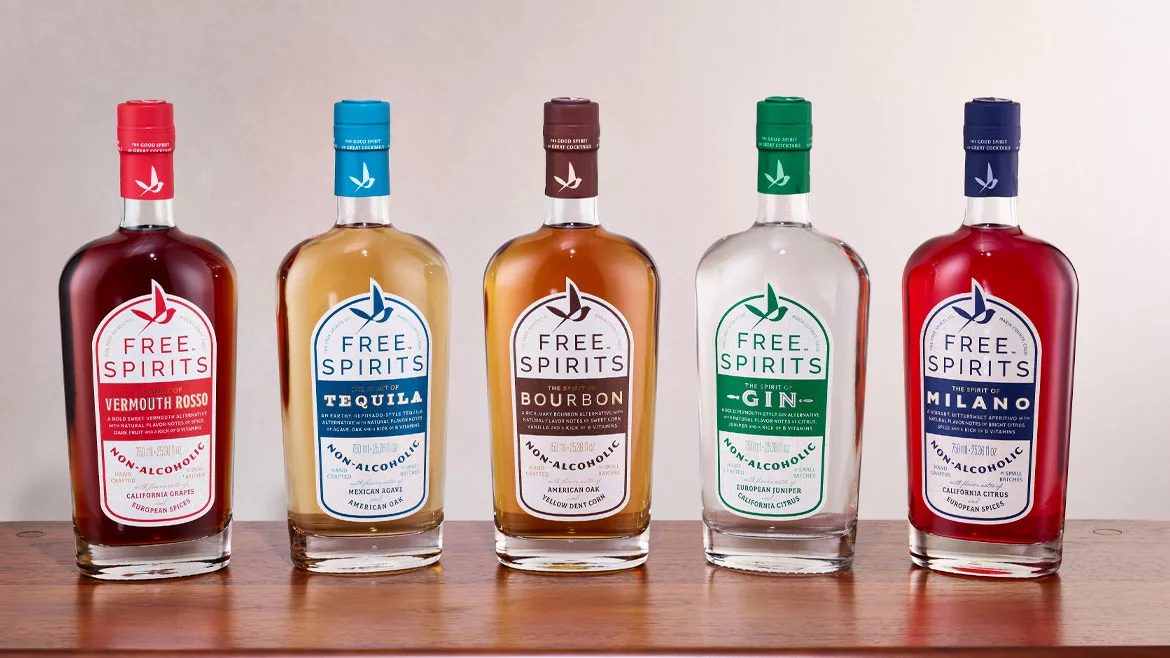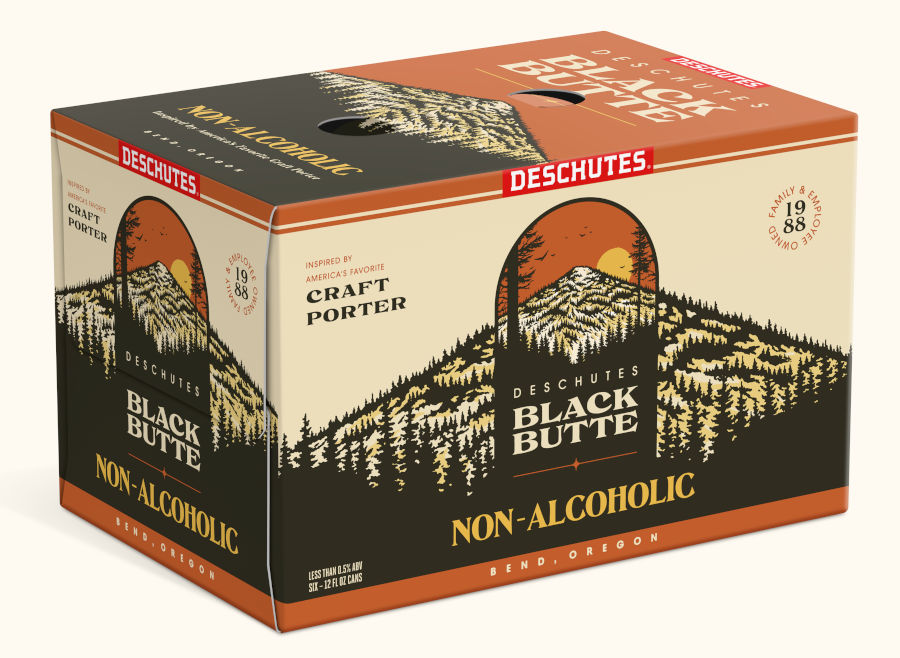Lifestyle trends drive growth for non-alcohol category
Moderation gaining ground in cocktail, mocktail culture

Image courtesy of The Free Spirts Co.
In 440 BC, Hippocrates said, “Let food be thy medicine, and let thy medicine be food.” Although this idea suggests that a diet based on nutrient-rich foods and beverages can promote health and well-being, experts note that today’s health and wellness trends include mindfulness, which is playing a pivotal role in shaping the non-alcohol (NA) beverage space.
“I’m afraid the word ‘mindful’ has become a bit bankrupt these days but that’s really what we’re talking about here,” says Milan Martin, founder of The Free Spirits Co., Mill Valley, CA. “People are more aware of what they consume and concerned with the impact of what they consume has on their bodies, their mental health and the planet.
“The growth in the non-alcohol space is driven, in large part, by people deciding to moderate their alcohol intake yet still demanding exciting, adult beverages,” Martin continues.
Julie Galbraith, chief marketing officer at Deschutes Brewery, Bend, OR, echoes similar sentiments, noting that consumers are increasingly prioritizing their well-being, and this shift is driving significant changes in their beverage choices.
“For many, it’s not about completely giving up alcohol but rather about exploring alternative options, like non-alcoholic beer, that align with their health goals,” Galbraith says. “In fact, health and wellness are identified as the primary drivers of non-alcoholic beverage trends.
“We’re seeing a notable trend where consumers, particularly Gen Z and millennials, are embracing or expressing interest in a ‘sober curious’ lifestyle,” she continues. “Nearly three quarters of Gen Z and millennials are actively seeking out non-alcoholic alternatives that allow them to enjoy their favorite beverages while still prioritizing their health.”
Steve Hauser, president and CEO of Paulaner USA, White Plains NY, also points to how younger consumers are impacting the NA market.
“Certainly, there is a lot more sensitivity to including health and wellness in the planning process with certain demographic targets,” he says. “From a beer standpoint, younger, more health conscious consumers are of particular interest as they are now in what has been traditionally their peak consumption years.
“Beer suffers from a bit of a hangover from earlier non- and low-alcohol products of years ago,” he continues. “The key is to have great tasting products in this space that are communicated to consumers in a relevant and motivating fashion.”
Shifting social trends
Aside from health and wellness trends impacting the popularity of non-alcohol beverages, experts highlight how social trends also are influencing the market.
“Yes, a new focus on health and wellness is driving the growth of this category, but I tend to believe that people are waking up to the simple truth that alcohol isn’t as critical to a rich social experience as many of us were conditioned to believe,” Free Spirits’ Martin says. “More isn’t always more when it comes to booze.
“The other piece I believe is a factor is social media,” he continues. “When I was drinking through my 20s in NYC, the only real ‘records’ of bad behavior were the fuzzy memories of those directly around you. And most of those memories faded over time. These days, we know that the internet never forgets and more people are just more aware of that and intent on managing perception and reputation.”

Laura Taylor, founder of Mingle Mocktails, Philadelphia, points to how the sober curious movement has gained more traction in recent years — driving market growth.
“We have seen people participate in Dry January, Dry July and Sober October for years, but more recently, we are seeing more and more people carrying the ‘challenge’ well past the end of the month,” she says. “Trends like Dry January and Sober October are definitely huge drivers of the growth of the non-alcoholic industry, because we see people realizing that even if they don’t want to give up alcohol entirely, they have more alcohol alternatives for their everyday life than they initially realized.”
“Another huge trend is that younger people are leading healthier lifestyles,” Taylor continues. “Gen Z has a much more balanced relationship with alcohol where mindful drinking and being alcohol-free is normalized. As a parent of a college student, I’m thrilled that young adults have options which support a healthier lifestyle, as they can be social without having to feel left out.”
Deschutes’ Galbraith notes that aside from healthy offerings, consumers also seek brands that align with their values.
“Firstly, consumers are increasingly seeking brands that resonate with their values and lifestyle choices. They want to feel good about their purchases and are drawn to brands they trust,” she explains. “This presents an opportunity for us to deliver innovative and appealing non-alcoholic options that align with consumers’ preferences and build meaningful connections with our audience.
“While health considerations drive many consumers to seek out alcohol alternatives, there are also occasion-specific needs driving this trend,” Galbraith continues. “For example, consumers may opt for non-alcoholic beverages to enjoy while socializing with friends, dining out, or other situations where responsible consumption is a priority, such as driving. By understanding these diverse consumer needs, we can innovate and build brands that deliver on a broader range of non-alcoholic beer offerings for our consumers.”
Meeting the moment
As the non-alcohol category continues to grow, brands continue to create innovative products to meet consumers' various need states.
“By prioritizing flavor and taste, we’re meeting the needs and expectations of today’s consumers and providing them with non-alcoholic alternatives that align with their lifestyle choices,” Deschutes’ Galbraith says. “At Deschutes Brewery, our commitment to exceptional innovation has been recognized by recent successes, including winning a Gold Medal at the 2024 World Beer Cup in the non-alcoholic beer category for Black Butte Non-Alcoholic.
“Building on this momentum, we've recently introduced Fresh Squeezed Non-Alcoholic IPA to our portfolio,” she continues. “Leveraging our patented and proprietary brewing process, we're able to craft non-alcoholic beers that deliver on taste without compromising on quality.”

Paulaner’s Hauser explains that the company is fortunate to represent two suppliers whose time-honored reputation of producing high-quality malt beverages provide a solid starting point for non-alcohol and low-alcohol products.
“From Paulaner, our low alcohol Paulaner Grapefruit Radler is a blend of our classic Münchner Lager and a unique Grapefruit infusion,” Hauser says. “At 2.5% alcohol it’s refreshing and does not fill you up. Paulaner Weizen-Radler 0.0% ABV combines the great taste of Paulaner Hefe-Weizen with natural effervescent lemonade in a non-alcoholic alternative for refreshingly fruity yet malty taste. Citrus notes of lime, orange and lemon.”
Mingle’s Taylor points to how consumers are gravitating toward ready-to-drink products that are flexibly mixable. “With products like these, they can easily be enjoyed on their own or mixed into a more complex mocktail or cocktail, meaning that the flexible product matches many of these consumers’ alcohol-flexible lifestyle,” she says.
Noting that Mingle offers six sparkling, ready-to-drink canned Mocktails inspired by cocktails, Taylor adds that the entire range is low-calorie, low-sugar and is made using minimal, clean ingredients.
“Our products don’t taste like alcohol and don’t use any adaptogens — which can be triggering for those in recovery — and instead use delicious blends of fruit juices and botanicals along with a refreshing effervescence to provide a sophisticated flavor that can be enjoyed by all, whether they are truly sober or just taking a day off,” she says.
Free Spirits' Martin echoes similar sentiments, noting that offerings that enable people to participate in the cocktail culture are growing significantly.
“When I founded Free Spirits, I guess I just decided that enabling people to continue drinking Margaritas, for example, while enabling them to dial up or down the alcohol they consume was a faster path than re-educating the world on what kind of cocktails to drink,” Martin says.
Free Spirits currently has five expressions: The Spirit of Bourbon, The Spirit of Tequila, The Spirit of Gin, The Spirit of Vermouth Rosso and The Spirit of Milano.
Martin notes that the company also just introduced its new line of “fresh-out-of-the-shaker ready-to-drink cocktails”— a classic Margarita made with The Spirit of Tequila and fresh lime juice, and a Kentucky Mule, made with The Spirit of Bourbon and fresh ginger.
“I’ve always believed that the role that ethanol plays in an alcoholic cocktail is important in making it that complex, slow-drinking experience so many of us are familiar with,” Martin says. “What’s more, you could argue alcohol is the original ‘functional’ ingredient (I’d argue it can be dysfunctional in excess but I digress). With that, all of our expressions have both natural ingredients that mimic the warming burn of ethanol and also have functional ingredients that deliver a little kick.”
Innovating for the future
Looking ahead, Mingle’s Taylor predicts that the continued advancement of available flavor profiles in the non-alcohol space will play a big factor in the growth of the industry.
“We recently released a new Sparkling Raspberry Rosé flavor in anticipation of the summer months and Rosé season, and those types of flavor innovations that provide non-alcoholic alternatives other than zero-proof beer will play a big role in growing the market,” Taylor says. “We’ve also piloted new variety pack programs based on the success of existing variety packs in the canned cocktail market.
“I think we’ll also see the use of functional ingredients like adaptogens and nootropics continue to play a role in growing the space as people look to decrease their alcohol consumption, and replace it with products that provide functional benefits,” she continues.
Deschutes’ Galbraith believes that the future of NA beer dwells in delivering a craft beer experience.

“At Deschutes, we firmly believe that beer enthusiasts shouldn’t compromise on flavor, aroma, or mouthfeel, just because it doesn’t contain alcohol,” she says. “That's why we’ve confidently introduced non-alcoholic versions of our best-selling beers. Black Butte Non-Alcoholic and Fresh Squeezed Non-Alcoholic IPA have quickly become fan and industry favorites, delivering the full craft beer sensory experience without the alcohol.”
Free Spirits’ Martin anticipates that innovation within the category has only just begun.
“I love the Reed Hoffman (founder of LinkedIn) quote, ‘If you’re not embarrassed by the first version of your product, you’ve launched too late.’” Martin says. “And I think that most of us at The Free Spirits Company would admit, some of our early products were ‘fine’ but we committed to running this thing like a software company, improving each ‘release’ with something new, something that pushes the category and the consumer experience forward.”
To Martin, early adopters of any category are going to give a lot of leeway, allowing a product to evolve. “... But to scale a category into the masses, that product needs to perform without excuse,” he says. “And I think we’re really getting there.
“If you look at some of our second-generation products like our Spirit of Tequila, it can stand toe-to-toe with an alcoholic tequila in terms of the boldness of flavor and the complexity of a reposado. We’ve had people complain that our Kentucky Mule, for example, tastes too much like a boozy cocktail,” Martin continues. “And yes, there will be more innovation from us and the category on exciting functional ingredients with efficacy but, like so many other categories, taste rules and everything else follows.”
Looking for a reprint of this article?
From high-res PDFs to custom plaques, order your copy today!






